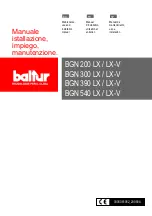
30
• Flue pipe system. Check for blockage and/or leakage.
Check the outside termination and the connections at and
internal to the furnace.
• Heat exchanger. Check for corrosion and/or buildup within
the heat exchanger passageways.
• Burners. Check for proper ignition, burner flame, and flame
sense.
• Wiring. Check electrical connections for tightness and/or
corrosion. Check wires for damage.
• Filters.
F
ILTERS
WARNING
T
O AVOID PROPERTY DAMAGE, PERSONAL INJURY OR DEATH, DISCONNECT
ELECTRICAL POWER BEFORE REMOVING FILTERS OR PERFORMING ANY OTHER
MAINTENANCE.
N
EVER OPERATE FURNACE WITHOUT A FILTER INSTALLED
BECAUSE DUST AND LINT WILL BUILD UP ON INTERNAL PARTS RESULTING IN
LOSS OF EFFICIENCY, EQUIPMENT DAMAGE AND POSSIBLE FIRE.
A return air filter is not supplied with this furnace; however, there
must be a means of filtering all of the return air. The installer will
supply filter(s) at the time of installation.
F
ILTER
M
AINTENANCE
Improper filter maintenance is the most common cause of
inadequate heating or cooling performance. Filters should be
cleaned (permanent) or replaced (disposable) every two months
or as required. When replacing a filter, it must be replaced with a
filter of the same type and size.
Become familiar with filter location and procedures for removal,
cleaning and replacing them. If help is needed, contact the installer
of the furnace or a qualified servicer.
F
ILTER
R
EMOVAL
Depending on the installation, differing filter arrangements can
be applied. Filters can be installed in either the central return
register or a side panel external filter rack (upflow only). A media
air filter or electronic air cleaner can be used as an alternate filter.
Follow the filter sizes given in the Recommended Minimum Filter
size table to ensure proper unit performance.
To remove filters from an external filter rack in an upright upflow
installation, follow the directions provided with external filter rack
kit. To remove internal filters see
Internal Filter Removal
section.
Internal filters are an accessory item and are not included with
your furnace. For further details, see your distributor.
U
PRIGHT
F
ILTER
R
EMOVAL
To remove filters from an external filter rack in an upright upflow
installation, follow the directions provided with external filter rack
kit.
Clean, wash and dry a permanent filter. When using a metal filter,
both sides should be sprayed with a dust adhesive as
recommended on adhesive container. Spray adhesives for use
with permanent metal filters can be found at some hardware
stores. BE SURE AIRFLOW DIRECTION ARROW POINTS
TOWARDS THE BLOWER.
Inspect filter. If your dirty filter is the disposable type, replace dirty
with the same type and size filter. If your dirty filter is a permanent
metal filter, clean as follows:
• Wash, rinse, and dry the permanent filters. Both sides
should then be sprayed with a filter adhesive as is
recommended on the adhesive container. Many hardware
stores stock spray adhesives for use with permanent filters.
• If badly torn or uncleanable, these filters must be replaced
by equal size permanent, high velocity filters. Throwaway
filters must not be used as replacement for permanent
filters. Under normal use, permanent filters should last for
several years.
I
NDUCED
D
RAFT
AND
C
IRCULATOR
B
LOWER
M
OTORS
The bearings in the induced draft blower and circulator blower
motors are permanently lubricated by the manufacturer. No further
lubrication is required. Check motor windings for accumulation
of dust which may cause overheating. Clean as necessary.
F
LAME
S
ENSOR
(Q
UALIFIED
S
ERVICER
O
NLY
)
Under some conditions, the fuel or air supply can create a nearly
invisible coating on the flame sensor. This coating acts as an
insulator causing a drop in the flame sense signal. If the flame
sense signal drops too low the furnace will not sense flame and
will lock out. The flame sensor should be carefully cleaned by a
qualified servicer using emery cloth or steel wool. Following
cleaning, the flame sense signal should be as indicated in the
Specifications Sheet.
I
GNITER
(Q
UALIFIED
S
ERVICER
O
NLY
)
If the igniter and the surrounding air are at about 70°F and the
igniter wires are not connected to any other electrical components,
the resistance of the igniter should not exceed 75 ohms. If it does,
the igniter should be replaced.
B
URNERS
WARNING
T
O PREVENT PERSONAL INJURY OR DEATH, DO NOT REMOVE ANY INTERNAL
COMPARTMENT COVERS OR ATTEMPT ANY ADJUSTMENT.
E
LECTRICAL
COMPONENTS ARE CONTAINED IN BOTH COMPARTMENTS.
C
ONTACT A
QUALIFIED SERVICE AGENT AT ONCE IF AN ABNORMAL FLAME APPEARANCE
SHOULD DEVELOP.
Periodically during the heating season make a visual check of the
burner flames. Turn the furnace on at the thermostat. Wait a few
minutes, since any dislodged dust will alter the normal flame
appearance. Flames should be stable, quiet, soft and blue with
slightly orange tips. They should not be yellow. They should
extend directly outward from the burner ports without curling
downward, floating or lifting off the ports.







































